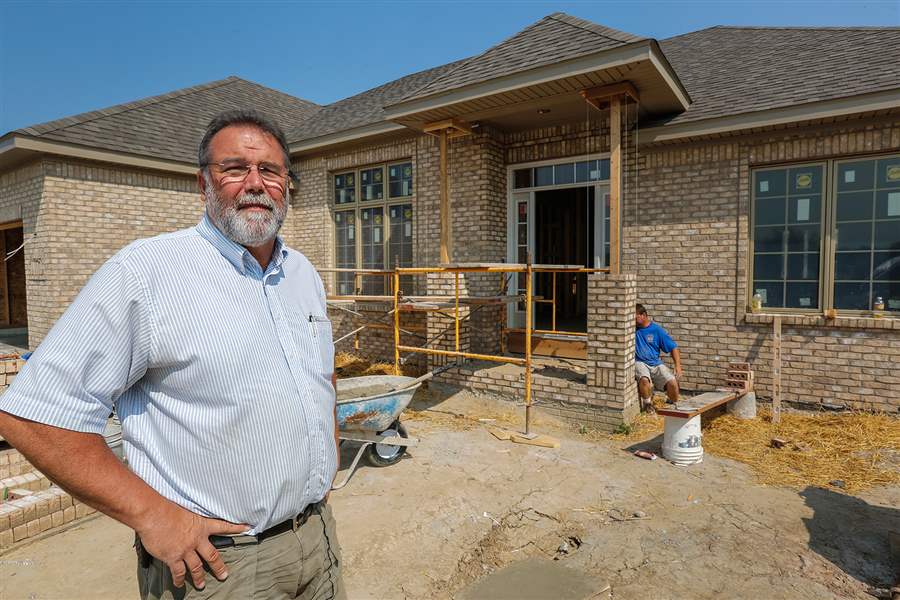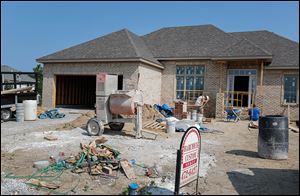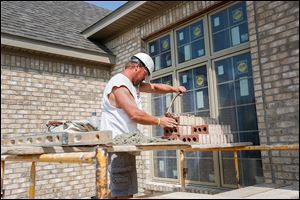
New-home construction pace gets brisker, area builders say
Optimism grows in industry, but recession effects still felt
8/3/2014
Chuck Barchick, front, stands in front of 7514 Pinafore Lane in Maumee as Sean Mowery works on the Barchick Custom home. Mr. Barchick, also head of the Home Builders Association of Greater Toledo, says his company has four homes under construction.
THE BLADE/JETTA FRASER
Buy This Image

Chuck Barchick, front, stands in front of 7514 Pinafore Lane in Maumee as Sean Mowery works on the Barchick Custom home. Mr. Barchick, also head of the Home Builders Association of Greater Toledo, says his company has four homes under construction.
Rick Macek of Macek Custom Builders has spent the last few years focusing on renovation jobs, but he’s recently started taking calls from people who are testing the waters of building a brand new home.
“Until I get them signed on the dotted line you can never say, but I’ve given three quotes in the last month, where in the past that would be in a year,” he said. “That’s pretty good. I’m encouraged by it.”
Area home builders such as Mr. Macek say they’re busier now than they have been in years, but the market for new construction in the Toledo area remains far below what it was before the Great Recession struck.
In 2004, nearly 1,600 new single-family homes went up in Lucas and Wood counties. By 2009, that number had withered to 268. Many established home builders took up remodeling jobs to survive. Some relative newcomers were pushed out of business.
Toledo’s real estate market has hardly boomed since then, but it has rebounded. During the last four years, existing homes in Lucas and upper Wood counties are selling for more money and are selling faster. According to the Toledo Board of Realtors, the average selling price through June was $116,513, up 17 percent from the same period in 2011. Meanwhile, the average home is on the market 114 days this year, down from 129 days in 2011.
Those modest market improvements are extending to new construction.
At a recent board meeting for the Home Builders Association of Greater Toledo, board president Chuck Barchick was apologetic. It was a few minutes after 3 p.m., and he was the only one there. However, he was willing to forgive the tardiness. The other members, he said, were out on job sites.
“About four years ago you could have come in here, and we’d have all been sitting here,” he joked, gesturing to the empty chairs.
Building activity in Lucas and Wood counties has indeed been on the rise. According to public records supplied to The Blade, the number of permits for new construction of single-family homes rose from 276 in 2011 to 531 last year. The vast majority of that activity has been in the western suburbs of Toledo, primarily in Monclova Township and Sylvania Township. The two accounted for nearly three-quarters of all building activity last year.
Through the first half of this year, 239 permits have been issued in the two counties. That’s slightly behind last year’s pace, but builders think there’s sufficient demand to make that up over the year’s second half.
In Michigan’s Bedford Township, 35 homes were under construction in the year’s first six months, putting the township on pace for the most new construction since 2007, when 78 single-family homes were built. The number fell to 25 in 2009 but rose to 66 last year.
Mr. Barchick, who has run Barchick Custom Homes for 22 years, has four homes under construction.
“It just seems like people are a little more geared to spending money,” he said.
Many reasons
Mr. Barchick points to a combination of factors contributing to the improvement. A better economy has people feeling more stable, interest rates remain low, and the rising price of existing homes makes new construction more appealing. That has been one of the major hurdles to new construction, not just in Ohio, but everywhere.

Mason Kenneth Collignon, left, and Sean Mowery work. The majority of building activity has been in Toledo’s western suburbs.
As prices tumbled on existing stock, builders could do little to lower their prices.
“It was tough to compete against the existing market,” Mr. Barchick said. “When you come into this neighborhood and it had a value of $250,000 and all of a sudden it’s $200,000 — we couldn’t build that house for $200,000, so why build houses? We just couldn’t compete against it.”
Little by little, that’s changing, those in the industry say.
“I think the builders are more optimistic now than they’ve been in the last three to four years,” said Vince Squillace, executive vice president of the Ohio Home Builders Association. “They’re busier now than they’ve been. The traffic in subdivisions and their model homes has picked up. Developers are thinking of developing land now.”
Prior to the recession, Mr. Squillace said Ohio had been averaging somewhere in the range of 44,000 housing starts a year. That dropped to about 12,000 at the market’s bottom. It’s been rising since, though slowly. This year, the organization is hopeful for between 16,000 and 20,000 starts.
Earlier this year, many experts were predicting the housing market finally would break free. Some were predicting as much as a 30 percent boost in housing starts this year. After a disappointing June, that looks unlikely.
Still, Robert Denk, senior economist at National Association of Home Builders, said that while progress has been slow, it’s still progress. He called the June results, where housing starts in the southern region tumbled, a fluke.
“Everybody is scratching their heads about why that happened, because the South really has been part of the strength,” he said.
The association and others now expect about 1 million starts this year, a 10 percent increase from last year.
Most economists say a pent-up demand for housing will have to be released eventually. Mr. Denk said the recession kept between 2 million and 3 million households from forming. Additional momentum should come from normal U.S. population growth and the need to replaceme older homes.
Effect on OC
That the housing industry is still in a tepid recovery is yet another curious aspect of the Great Recession.
“This has been a strange sort of recovery out of a very deep recession,” said Julian Francis, vice president and general manager of residential insulation for Owens Corning. “Every other recession going back to post-World War II has been led by housing. Housing has been a big driver. This time around it’s been a drag on the economy.”

Mason Kenneth Collignon works on the Pinafore Lane home in the Blystone Valley subdivision in Maumee. Many experts, though puzzled that housing is not leading the economic recovery, agree that the improvements have been solid.
The Toledo-based company produces both insulation and roofing materials, making it heavily exposed to the building industry. Higher prices have helped OC’s insulation business, but roofing has proved challenging. Shares of the company’s stock have lost about 8 percent this year.
But like Mr. Denk, Mr. Francis and OC are confident the demand is there. And even though growth has not lived up to expectations, it’s still solid.
“In any market, double-digit growth is an exciting place to be,” he said. “Going from 900,000 to 1 million looks pretty good when we were at 600,000 three or four years ago.”
The National Association of Home Builders believes that housing starts will rise to about 1.2 million in 2015 and 1.5 million in 2016. Those figures include both single-family and multifamily homes, though single-family homes make up the majority of the market.
How far the industry may come back in Toledo remains up in the air. Population growth is the key driver for new housing, and Lucas County has been losing people for several years. The U.S. Census Bureau estimates the county lost about 5,400 people from 2010 to 2013, a decrease of about 1 percent. Wood County has added about 3,800 people over that time, a 3 percent gain.
Mr. Barchick doesn’t know that the area can support 1,000 new homes a year like it did in the run-up to the housing bust.
“I think that was everybody thinking the music is never going to stop, and unfortunately it did, and there were only so many chairs to sit down in,” he said.
Contact Tyrel Linkhorn at: tlinkhorn@theblade.com or 419-724-6134.